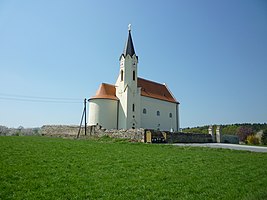Fuglau
|
Fuglau (village) locality cadastral community Fuglau |
||
|---|---|---|
|
|
||
| Basic data | ||
| Pole. District , state | Horn (HO), Lower Austria | |
| Pole. local community | Altenburg | |
| Coordinates | 48 ° 38 '47 " N , 15 ° 32' 51" E | |
| height | 450 m above sea level A. | |
| Residents of the village | 105 (January 1, 2020) | |
| Area d. KG | 6.53 km² | |
| Post Code | 3591 | |
| prefix | + 43/02989 | |
| Statistical identification | ||
| Locality code | 03899 | |
| Cadastral parish number | 10019 | |
| Counting district / district | Fuglau (31 101 002) | |
 View of the St. Nikolaus branch church in Fuglau. |
||
| Source: STAT : index of places ; BEV : GEONAM ; NÖGIS | ||
Fuglau is a place and a cadastral municipality in the municipality of Altenburg (Lower Austria) in the Horn district in Lower Austria .
geography
The place is on the southwestern edge of the Horner Basin . The altitude in the town center is 450 meters. The area of the cadastral community covers 6.53 km². The population is 130 people (as of 2001).
Fuglau has the postcode number 3591.
Population development
| Population development of Fuglau between 1830 and 2001 | ||||||
| 1830 | 1869 | 1951 | 1961 | 1971 | 1991 | 2001 |
|
271 |
295 | 217 | 172 | 169 | 124 | 130 |
history
Fuglau is first mentioned in a document in 1144. In a Latin document from Altenburg Abbey from around 1220, an Udalricus de Uugla (Fuglau) is mentioned as a witness. Probably in the 13th century a fortified church was built on a hill above the village , which was destroyed by the Hussites around 1430 . In modern times, the Altenburg Abbey held local authority. In 1938 Fuglau was incorporated into Altenburg , and from 1945 the place was again an independent municipality. In the course of the amalgamation of the municipalities, the place became a part of the newly formed large municipality Altenburg on January 1st, 1970.
Culture and sights
- Filial church of St. Nicholas
- The building, erected in the 13th century as a fortified church , was destroyed by the Hussites around 1430 . Around 1680 the nave was rebuilt in Baroque style, followed by a tower in 1750, which was re-gothicized around 1860.
Economy and Infrastructure
traffic
Fuglau is on Böhmerwald Straße (B38) and Landesstraße 4088. The PostBus bus company drives to the Fuglau Gh Eisenhauer stop on line 1923 ( Horn - Rastenfeld ) in Fuglau . The closest ÖBB train stations are Horn NÖ and Rosenburg an der Kamptalbahn . On the northern outskirts of Fuglau located to the north ring (originally Muckgrubenring and Britaxring ) an automobile race track, since the mid-1970s national and international Rallycross - and autocross -race are held, including already many FIA - European championship races . The operator of the Nordring is the Fuglau innkeeper Franz Eisenhauer.
Web links
- Website of the Altenburg community
- Literature about Fuglau in the Lower Austrian State Library
- Pictures of Fuglau in the topographical collection of the Lower Austrian regional library
Individual evidence
- ↑ Historisches Ortlexikon Niederösterreich ( Memento of the original dated November 5, 2010 in the Internet Archive ) Info: The archive link was inserted automatically and not yet checked. Please check the original and archive link according to the instructions and then remove this notice. (PDF; 1.2 MB), part 2, p. 34.
- ^ Fontes Rerum Austriacarum . Sources on Austrian history, ed. from the Historical Commission of the Imperial Academy of Sciences in Vienna, vol. 8, part 2, Vienna 1855, p. 215. ( books.google.de )
- ^ Michael Rademacher: German administrative history from the unification of the empire in 1871 to the reunification in 1990. aus_horn.html. (Online material for the dissertation, Osnabrück 2006).
- ↑ Thomas Hofmann, Erich Rabl, Wolfgang Stangl: Horner Mosaike - Another home book. Texts and pictures from the Horn district . Weitra 2005, ISBN 3-85252-683-3 , pp. 199-200.
- ^ Franz Eppel: The Waldviertel. His works of art, historical forms of life and settlement. 8th edition Salzburg 1984, ISBN 3-900173-01-X , pp. 104-105.

